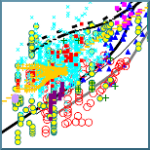EPJ B – New theory predicts dispersion in porous solids
- Details
- Published on 08 April 2011

Modeling the transport of fluids in porous solids is a problem of general interest for its implications in construction engineering, industrial catalysis, hydrology, agriculture and geology. The classical approach uses an equation derived from continuum mechanics which is problematic and often gives incorrect predictions. When the porous medium presents many scales of variability the problem becomes intractable.
In this colloquium paper in EPJB, A. Hunt and co-workers present a new theory that blends concepts taken from random resistor networks and percolations theory and considers the microscopic parameters of the system. The authors test the theory by comparing it with more than 2200 experiments over length scales from a few microns to 100km. The comparison focuses on the dispersivity.
The good agreement between the new theory and experiments requires rethinking the relevance of diffusion and multi-scale heterogeneity. It would also signal the inappropriateness of the classical advection-dispersion equation or any of its derivations to model solute transport.
To read the full paper "Dispersion of solutes in porous media" by A.G. Hunt et al., Eur. Phys. J. B (2011) click here





